Brown bears are large mammals with long, shaggy hair and big appetites. Most North American brown bears are part of the sub-species called grizzly bears. Their thick coats aren’t always all-brown, but they all live to scavenge food. So what do brown bears eat during their many hours of scavenging? Practically every food they can find!
Keep reading to learn more about a brown bear’s diet, how they hunt, and what brown bears eat to prepare for hibernation. We’ll also look at circumstances where bears might be dangerous to humans. Here’s a hint – don’t give them a reason to think you have snacks.
What Do Brown Bears Eat?
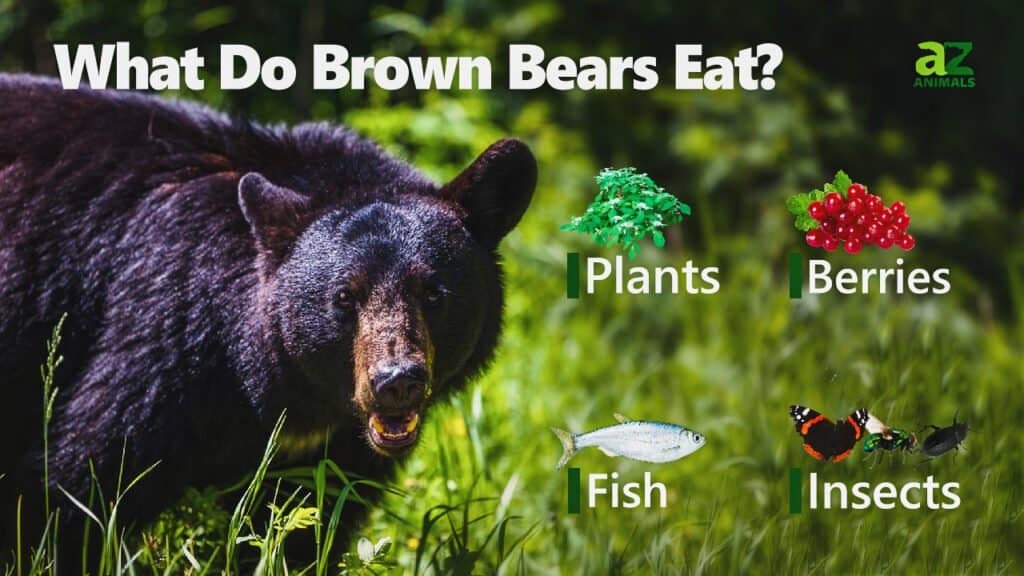
Brown bears eat berries, bulbs, roots, and animal foods like squirrels, insects, and fish. Brown bears are omnivores, though about 90% of their diet consists of plant foods.
The brown bear is considered one of the most omnivorous creatures in the animal kingdom. In other words, this bear isn’t a picky eater! In addition to the foods mentioned above, a brown bear forages for fruit, flowers, moss, and grasses. It also loves different kinds of fungi, like mushrooms, and eats acorns and pine cones from area trees.
Animals hunted by the brown bear are usually small. Marmets, mice, and squirrels are common prey. This bear also eats carrion (already deceased animals), baby animals like fawns (baby deer), and might kill an injured animal in their path. Brown bears that live on the coast will dig for clams and spend hours in the water attempting to catch fish like salmon and trout.
A Kodiak bear is a type of brown bear in Alaska and one of the five largest land mammals in North America. Kodiak bears probably eat more than any other brown bear, requiring a very high amount of calories per day. The largest brown bear ever was a Kodiak caught by humans in 1894. It weighed 1,656 pounds!
Here’s a list of common foods brown bears eat:
- Acorns
- Baby Animals (like Fawns)
- Bark
- Berries
- Birds
- Bulbs
- Carrion
- Clams
- Crab
- Eggs
- Fish
- Flowers
- Forbs
- Fruit
- Funji
- Grasses
- Herbs
- Insects
- Larvae
- Leaves
- Lemmings
- Marmots
- Mice
- Moss
- Moths
- Nuts
- Pine Cones
- Rats
- Roots
- Sedges
- Shoots
- Squirrels
- Voles
How Does the Brown Bear Hunt?
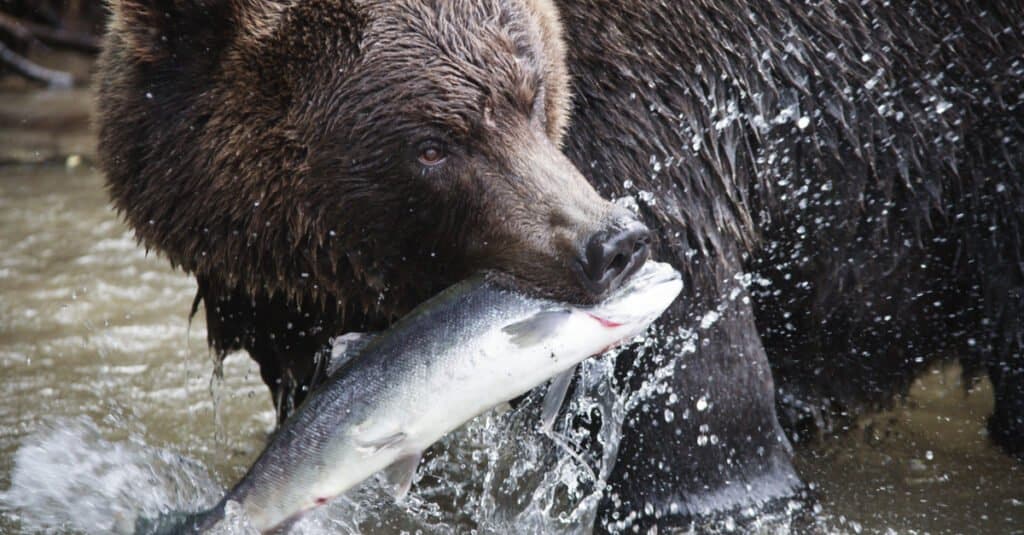
A brown bear spends many hours a day hunting for food.
©DPS/Shutterstock.com
Very few plants and animals are a match against the brown bear’s massive paws and long claws. Whether foraging or hunting, anything snagged by those claws is destined to be dinner.
And this bear can be very patient on the hunt, if necessary. Adult brown bears are usually too large to climb trees to catch their prey but might wait at the bottom for the animal to fall or come back down.
Despite their hefty size, brown bears can run fast to catch their target. According to National Geographic, some brown bears can run at least 30 miles per hour.
One of the incredible facts about grizzly bears is they have a keen sense of smell that’s 2100 times stronger than that of humans! So, it’s safe to say that the grizzly bear can sniff out their next meal with ease.
When a brown bear hunts fish, it can do so in several ways. It might search in shallow pools of water where salmon gather to rest. It could stand in the river current and pounce on a school of fish swimming toward it. Or the bear might stand near the river edge and scoop fish from the water to send them flying toward the shore.
What Do Brown Bear Cubs Eat?
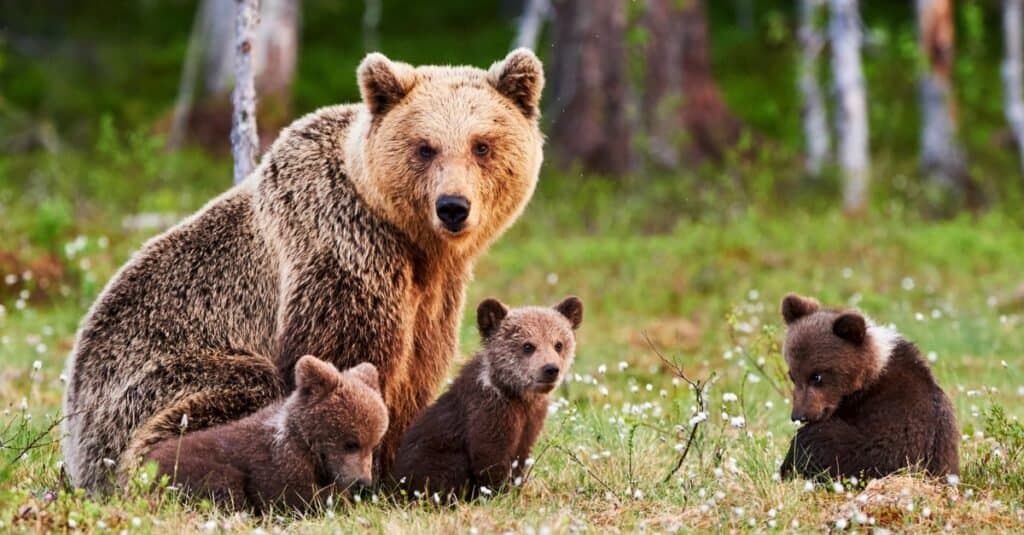
Cubs nurse from their mother for up to two years.
©iStock.com/LuCaAr
For the first few months of life brown bear cubs eat only their mother’s milk. Cubs are born during winter, so pregnant she-bears don’t get to rest as much in hibernation as male bears do. And, unlike most other mammals, the female brown bear can lactate to feed her young while not eating during hibernation months. She makes milk from the nutrients stored in her fat, muscles, and organs during this time.
A new mother stays in the den with her newborn cubs until spring, then she and the cubs begin to forage together for solid foods. Once she actively eats again, the mother bear’s milk production increases. As a result, her cubs nurse heavily through the summer months and grow rapidly. Though her milk supply will decrease as the days grow colder again, most brown bear mothers continue to nurse their cubs for their first two years of life.
What Do Brown Bears Eat in the Fall?
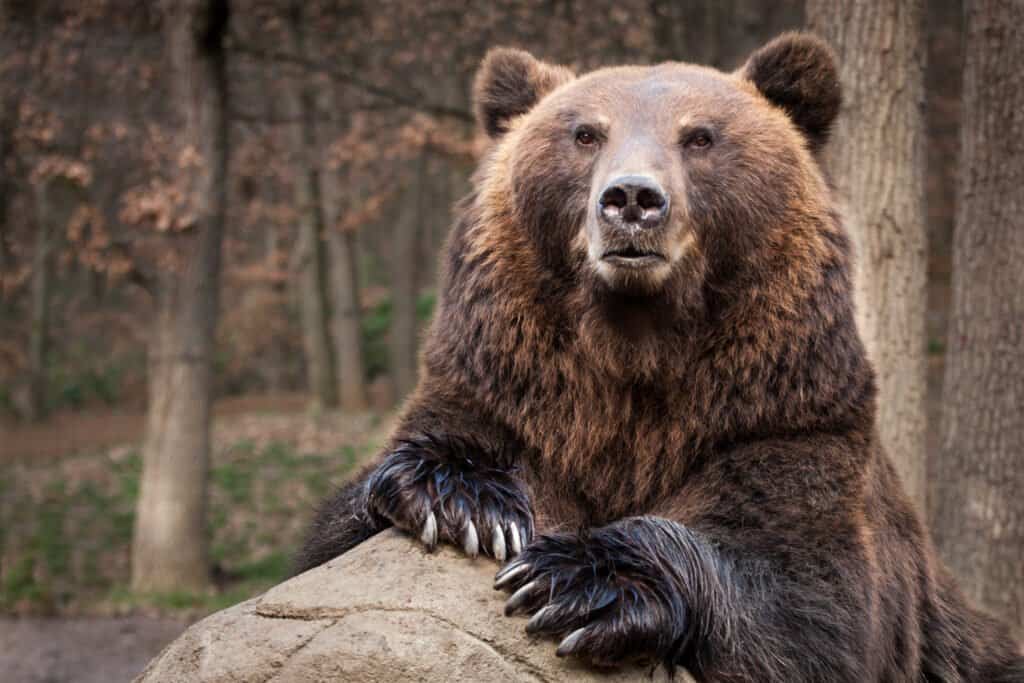
To prepare for hibernation, brown bears eat more in the fall than any other season.
©Marie Dirgova/Shutterstock.com
Because brown bears hibernate through the winter, they eat more in the fall than any other season – up to 90 pounds of food per day! Through spring and summer, these bears might eat around 8,000 calories on a daily basis. That number more than doubles in the fall when brown bears eat up to 20,000 or more calories every day.
All that food helps them pack on extra body fat. As the bear hibernates, the excess fat is broken down and used to supply its body with water and energy to stay alive.
The brown bear eats the same essential foods in the fall as it does in warmer months, though some favorites become scarce. When summer fruit, flowers, herbs, and leaves are no longer available in autumn, bears eat more bulbs, roots, small animals, and insects.
Brown bears can last without food during hibernation for at least 100 days if they eat enough before entering this resting phase called torpor. Where do bears hibernate? The brown bear usually curls up for torpor in a cave, holes in the ground, or a den they might make from a hollowed log.
Is the Brown Bear Dangerous to Humans?
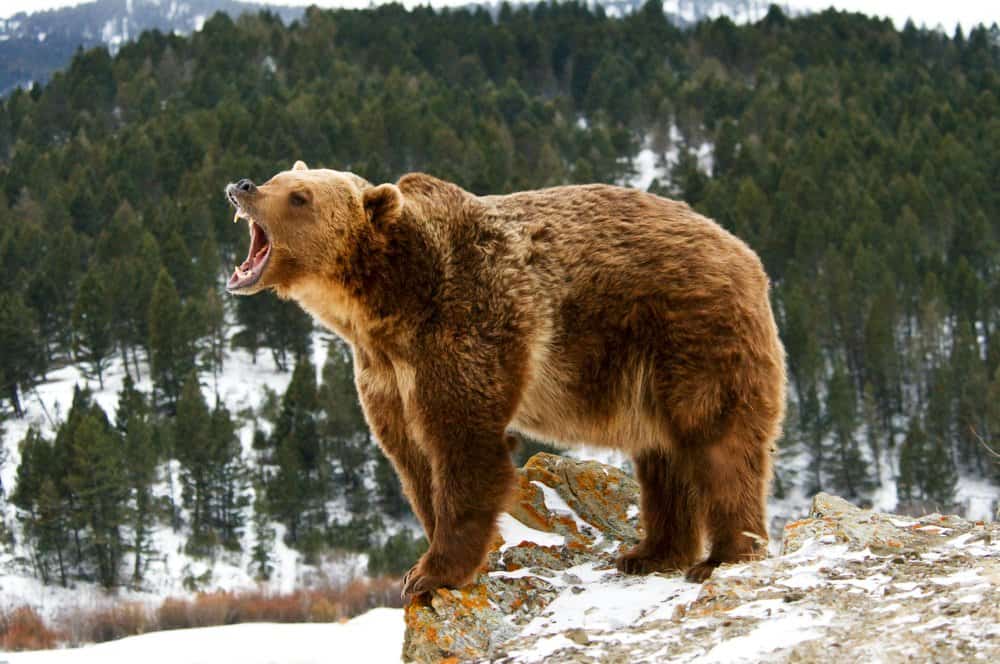
The brown bear can be dangerous to humans, so don’t let them smell your food or garbage.
©Scott E Read/Shutterstock.com
Brown bears eat many different plants and wild animals, but they don’t hunt humans for food. Yet a brown bear can be dangerous to humans in certain circumstances. For example, they might attack people if provoked, if they feel threatened, or if they have been conditioned to view humans as a source of food.
Mother bears (sows) are very protective of their cubs. Most North American bear attacks on humans have resulted from an agitated sow. So even if you don’t see their mother nearby, don’t get anywhere near brown bear cubs.
In addition, don’t leave food or garbage outside or in your vehicles if brown bears live in the area. If you go camping in bear country, lock anything with a scent (food, breath mints, toothpaste, lotions) in bear-proof containers. If possible, store those containers by hanging them high in a tree away from your immediate camp area or in a locked vehicle away from your camping spot.
Being noisy in a bear’s habitat could help protect you from a rare bear attack. Brown bears would much rather know you’re there than stumble upon you by surprise. And if a brown bear acts aggressive, signaling it might attack, don’t run. You cannot outrun a bear on the chase. Instead, brown bear experts recommend remaining calm and standing your ground in the hopes that the bear will walk away. If a brown bear does attack, lie on your stomach and pretend you are dead. You want the bear to lose interest in you and move on to scavenge for its next meal.
The photo featured at the top of this post is © WildMedia/Shutterstock.com
Thank you for reading! Have some feedback for us? Contact the AZ Animals editorial team.






